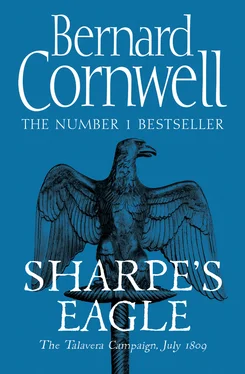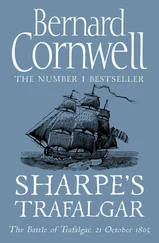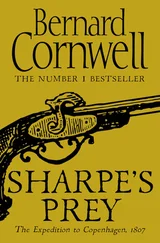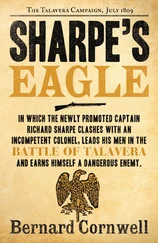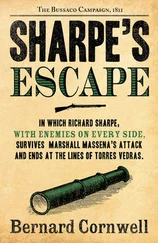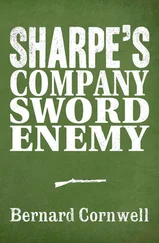SHARPE’S
EAGLE
Richard Sharpe and the Talavera
Campaign, July 1809
BERNARD CORNWELL


An imprint of HarperCollins Publishers
1 London Bridge Street
London SE1 9GF
www.harpercollins.co.uk
First published in Great Britain by Collins 1981
Previously published in paperback by Fontana 1981
Reprinted twelve times
Copyright © Rifleman Productions Ltd 1981
Map © John Gilkes 2011
Cover design by Holly Macdonald © HarperCollins Publishers Ltd 2019
Cover image © DeAgostini Picture Library/Scala, Florence
Bernard Cornwell asserts the moral right to be identified as the author of this work
A catalogue record for this book is available from the British Library
This novel is entirely a work of fiction. The names, characters and incidents portrayed in it are the work of the author’s imagination. Any resemblance to actual persons, living or dead, events or localities is entirely coincidental.
All rights reserved under International and Pan-American Copyright Conventions. By payment of the required fees, you have been granted the non-exclusive, non-transferable right to access and read the text of this ebook on-screen. No part of this text may be reproduced, transmitted, downloaded, decompiled, reverse engineered, or stored in or introduced into any information storage and retrieval system, in any form or by any means, whether electronic or mechanical, now known or hereinafter invented, without the express written permission of HarperCollins.
Ebook Edition © July 2009 ISBN: 9780007338641
Version: 2019-12-13
For Judy
‘Bernard Cornwell set out to create a character who was credible enough to go through many adventures and both Sharpe himself and his Irish sergeant, Patrick Harper, are excellent creations. To my taste, Sharpe is much more interesting than Flashman’
Financial Times
‘Every man thinks meanly of himself for not having been a soldier’
SAMUEL JOHNSON
Contents
Cover
Title Page SHARPE’S EAGLE Richard Sharpe and the Talavera Campaign, July 1809 BERNARD CORNWELL
Copyright Copyright An imprint of HarperCollins Publishers 1 London Bridge Street London SE1 9GF www.harpercollins.co.uk First published in Great Britain by Collins 1981 Previously published in paperback by Fontana 1981 Reprinted twelve times Copyright © Rifleman Productions Ltd 1981 Map © John Gilkes 2011 Cover design by Holly Macdonald © HarperCollins Publishers Ltd 2019 Cover image © DeAgostini Picture Library/Scala, Florence Bernard Cornwell asserts the moral right to be identified as the author of this work A catalogue record for this book is available from the British Library This novel is entirely a work of fiction. The names, characters and incidents portrayed in it are the work of the author’s imagination. Any resemblance to actual persons, living or dead, events or localities is entirely coincidental. All rights reserved under International and Pan-American Copyright Conventions. By payment of the required fees, you have been granted the non-exclusive, non-transferable right to access and read the text of this ebook on-screen. No part of this text may be reproduced, transmitted, downloaded, decompiled, reverse engineered, or stored in or introduced into any information storage and retrieval system, in any form or by any means, whether electronic or mechanical, now known or hereinafter invented, without the express written permission of HarperCollins. Ebook Edition © July 2009 ISBN: 9780007338641 Version: 2019-12-13
Dedication For Judy
Epigraph ‘Every man thinks meanly of himself for not having been a soldier’ SAMUEL JOHNSON
Map
Foreword
Preface
Chapter One
Chapter Two
Chapter Three
Chapter Four
Chapter Five
Chapter Six
Chapter Seven
Chapter Eight
Chapter Nine
Chapter Ten
Chapter Eleven
Chapter Twelve
Chapter Thirteen
Chapter Fourteen
Chapter Fifteen
Chapter Sixteen
Chapter Seventeen
Chapter Eighteen
Chapter Nineteen
Chapter Twenty
Chapter Twenty-One
Chapter Twenty-Two
Chapter Twenty-Three
Chapter Twenty-Four
Chapter Twenty-Five
Epilogue
Historical Note
Sharpe’s Story
Keep Reading …
About the Author
The SHARPE Series (in chronological order)
The SHARPE Series (in order of publication)
Also by Bernard Cornwell
About the Publisher
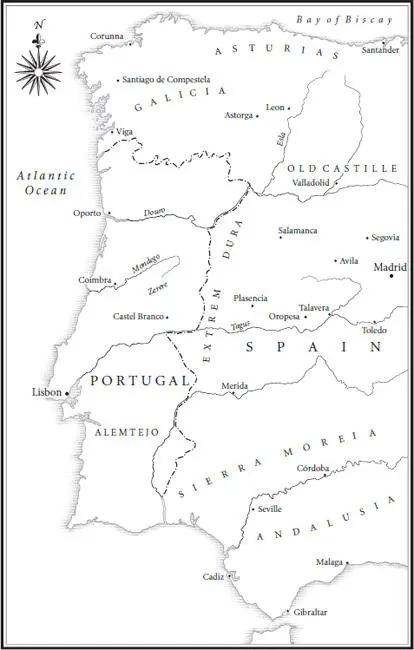

This was the first book I wrote, and it is the only book of mine that I have never dared go back and re-read. I still do not dare, for I am sure I would be horrified by the crudity of its writing, but I am constantly told by readers that it is one of their favourites.
It tells the story of the battle of Talavera, which occurred towards the beginning of the Peninsular War. It was not where I wanted to start the Sharpe series. I really wanted to begin with the tale of Badajoz (which turns up in Sharpe’s Company ), because Badajoz is such an extraordinary and dramatic event, but I decided it would be a good idea to write a book or two before Badajoz, rather like a bowler warming up before he takes on the opening batsman. I had never written a novel before, never tried to write a novel before, and so Sharpe’s Eagle is where I was going to make all a beginner’s mistakes, and where, if I was successful in my ambition to write a series of tales about the adventures of a British rifleman in the Napoleonic Wars, I was going to learn some of the tricks of the trade. One of the first things I learned was that Sharpe’s enemies, by and large, had to be British. I had thought, before I began writing, that the French would provide him with enemies enough, but the circumstances of war meant that Sharpe spent much more time with the British than with the enemy French, and if he was to be unendingly challenged, irritated, obstructed and angered then the provocations had to come from people with whom he was constantly associated. In time Sharpe is to meet many foul enemies, but few, I think, are as nauseating as Sir Henry Simmerson who, I seem to remember, becomes a tax inspector in his later career.
I said Sharpe’s enemies were British. In fact most of them, like me, are English, while his friends are often Irish. This arose from the happy fact that I had been living in Belfast in the years immediately prior to writing Sharpe and had acquired a fondness for Ireland which has never abated. It also reflected a truth that Wellington’s army was heavily recruited from the Irish, and indeed the Duke (as he was to become) had been born there. That was not a fact of which he was proud. ‘Being born in a stable,’ he once remarked, ‘does not make a man a horse.’ The Duke was a difficult, cold and snobbish man who was also one of the greatest soldiers ever to take the field. Like Sharpe I admire him, but would not particularly wish to dine with him. His story, though, is intimately linked with Sharpe’s, which is to Sharpe’s good fortune. But Sharpe, if he is to make his reputation, must do it with action, rather than by his distant connection with the Duke, and there was no act more admired on a battlefield than the capture of an enemy’s standard. In Napoleon’s army those standards took the form of small statuettes of eagles – thus the book’s title. I decided that if I was not to launch Sharpe against the great walls of Badajoz in his first adventure, then he should face another task just as impossible, and so I set him to capture an eagle. Poor Sharpe.
Читать дальше
